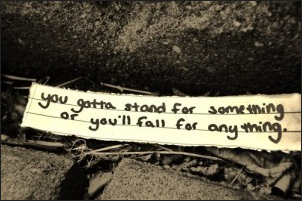This is a guest post from Spike Jones — Group Director of Engagement at WCG and co-author of the book Brains on Fire: Igniting Powerful, Sustainable Word of Mouth Movements. See the original post this is adapted from and more like it on his blog.
 As SXSW came to a close this year, there was a lot of chatter about the highs, lows, and in-betweens. But through all the clutter, there were a handful of things that stuck out for me — and one that got stuck in my craw.
As SXSW came to a close this year, there was a lot of chatter about the highs, lows, and in-betweens. But through all the clutter, there were a handful of things that stuck out for me — and one that got stuck in my craw.
It has to do with companies and causes.
There are, of course, many variations of this conversation. One of them is brand as cause, like Love146 or the World Wildlife Fund. In other words, they are brands that exist wholly around the cause that they stand for. Then there are the ones that have a product, but stand for that one north star. Take Patagonia, for example, which is committed to helping the planet and makes sure everything they make and do supports that cause. Check out their Common Threads and 1% for the Planet programs, just to name a few (or the fact that after two or three times that they sent me a catalog and I didn’t order anything, they asked if they could take me off their mailing list to save paper). Or even TOMS, a company that donates one pair of shoes to those in need for every one they sell.
And then there is, well, everyone else.
And this is where the conversations I heard land. These people were saying that if your brand doesn’t stand for something — a cause, if you will — then people won’t care about it. And I absolutely agree. Where I absolutely disagree, however, is that your brand needs to align itself with something like saving the planet or curing cancer in order for people to care about you.
Let’s go ahead and get it out of the way: I’m not saying that’s a bad thing or even an ineffective thing. But experience has taught me that a brand can stand on its own as a cause, you just sometimes (okay, a lot of times) have to get your hands dirty to find it. And instead of having some arbitrary cause that sounds good, why not find the one that matters to your customers?
For a crafting company, we found that their cause was to create a place that was safe online to share and celebrate each other’s work instead of the hostile communities that plagued the online space. For a city park client, it wasn’t planting trees and picking up trash. Their cause was celebrating the memories you make in a park with your family, your partner, etc. For a musical instruments initiative, it wasn’t about selling guitars and drum kits while looking for the next American Idol, but unlocking the music inside us all — no matter your skill level.
As an old colleague used to say, brands exist for two reasons:
- Solve my problem.
- Make me feel good.
It’s no secret that people want to be a part of something bigger than themselves.
But instead of looking outward for that cause, maybe you should look inward. Because when you find that thing to fight for, you are one step closer to putting a stake in the ground and defining who and what you are as a brand. And giving your customers something to fight for makes it even better.
About Spike Jones
Spike Jones is a results-proven communications professional, specializing in digital and offline word of mouth marketing. With more than 15 years of experience, the career path goes something like this: Baylor University; a decade at Brains on Fire; SVP of the Customer Experience team at Fleishman-Hillard; Group Director, Engagement at WCG; and now SVP, Managing Director SW Region at Edelman Digital. Spike is also a co-author of the book Brains on Fire: Igniting Powerful, Sustainable, Word of Mouth Movements.
- Web |
- More Posts (26)


